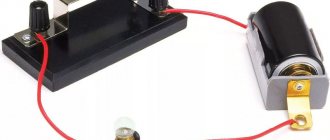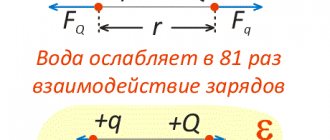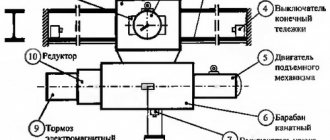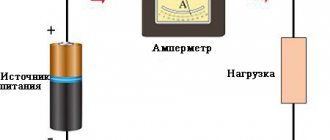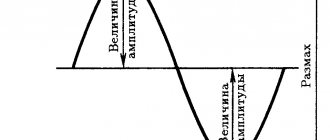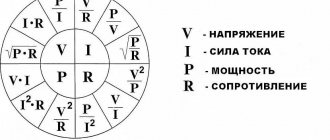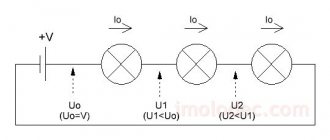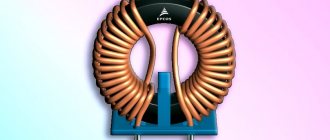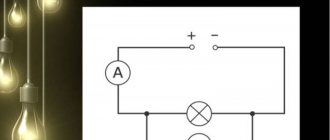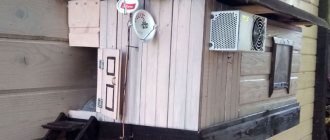In order for electric current to flow for a long time, several conditions must be met. One of them is the closed circuit. Its components ensure the creation of a circuit that allows charge carriers to flow. The minimum number of elements required for this is three. But the real chain can be as large as desired, although some parts must be in it.
General information
An electrical circuit is understood as a combination of various radio-electronic devices connected to each other by conductors. The task of such a set is to ensure the flow of electric current of the specified characteristics. The parameters of such a system are described using three main quantities:
- current - the ordered movement of charge carriers caused by external forces, for example, an electromagnetic field;
- voltage - the work performed to move a charged particle from one point of the body to another;
- resistance - a value that depends on the impedance of each element of the circuit.
There are two ways to analyze an electrical circuit - energy and information. The first refers to the study of processes associated with the transformation and transfer of energy. Finding currents and voltages in different places in the circuit. The second involves clarifying the reaction when the external influence changes.
There are two states of an electrical circuit - closed and open. If there is a gap in some place, no current will flow through it. This means that no potential difference (voltage) will appear between two points of the open section. A closed circuit allows the circulation of electrical charges. The connection between the elements of the circuit is carried out using conductors. That is, bodies with little resistance.
In order for electron movement to occur, a source of force—energy—is needed. This is a generator that produces current or voltage. They call it the source. The difference between generators is that the current one is able to maintain a constant current strength at its output, regardless of the rest of the circuit. The voltage source produces a constant electromotive force (EMF), the magnitude of which is not affected by the current in the circuit.
The generated energy must be directed somewhere, that is, used somewhere. A device that receives electricity is called a consumer. It can be any circuit element that is not a generator and has resistance.
Thus, the simplest electrical circuit consists of three elements - an energy source, conductors, and a consumer. A real electrical circuit can contain any number of consumers. Some of them can accumulate energy and then release it, while others only consume it, converting it into another form.
Operating conditions of current sources
Any current source operates under certain conditions. In the absence of a chemical reaction, charged particles cannot form within the elements. If there is no anode and cathode, then particle movement will not occur even in the presence of a reaction.
A similar process occurs in batteries, but the impetus for the occurrence of a chemical reaction is a short circuit in the external electrical circuit. Charged elements begin to move from the anode to the cathode and vice versa, creating a constant flow.
Ideal and real
Light types cannot work without a light source. The efficiency depends on the type of dielectric element used. Additionally, it is necessary to have a device available for converting the received energy.
The thermal option will not work if it is based on 1 type of metal. If there is no source of heat, then the emergence of moving particles is out of the question.
Sources
To generate electrical energy, you need to select a current source that meets the needs of your specific application. There are several options for such devices, each of which has a specific structure, operating principle and individual technical indicators.
Electrical circuit elements
Current and voltage sources belong to the active elements of the electrical circuit. These also include semiconductor devices, for example, transistors and diodes. Inductance, capacitor, resistance, on the contrary, are considered passive elements.
Depending on the parts included in the circuit, it can be passive or active. In the first case, it consists only of electrically independent elements, but if it has at least one active element, then the circuit is considered volatile.
Each device in the electrical circuit can be characterized from two sides:
- qualitative - depends on physical parameters, determines the purpose and function of the element;
- quantitative - characterizes the size of the device.
Power sources are divided into primary and secondary. The first include generators, that is, devices that convert various types of energy into electricity. They can be batteries, electric machines, galvanic batteries. Secondary sources convert electricity from one type to another. These include rectification, inversion, and transformation blocks.
Auxiliary elements are those that ensure the correct operation of the electrical circuit. These are all kinds of conductors, switching devices, measuring and protective equipment. The consumer is the equipment that converts electricity into useful work. For example, heating, ventilation devices, engines, various household and industrial equipment.
In other words, from the source, current begins to flow through conductors through a number of electronic devices, bringing its characteristics to the desired form. It is then applied to a load that provides resistance and performs work. Then, through the consumer, the current returns to the source. The closure of the line, regardless of the elements used, is necessary, since otherwise a potential difference does not arise.
Connecting elements in a circuit can be implemented in three ways:
- parallel - the beginning of various devices are connected at one point, and the ends at another;
- serial - all parts of the circuit are connected in turn to each other;
- mixed - a combination of the two previous types.
It is quite difficult to list all radioelements, since there are many of them. But the main ones can be distinguished: resistor, inductance, capacitor, transistor, diode, integrated circuit, light emitters and photodetectors.
Features of using the formula
The formulation of Ohm's law for a closed circuit includes only one resistance and one value of emf. However, in real circuits there are many elements, and several sources of emf are possible. In this case, the equivalent circuit resistance is used, which is found using special circuit conversion formulas. The sum of the source resistances is used as the internal resistance value. And the algebraic sum of the emf of the sources is used as the value of the emf.
If the circuit is very complex and is made up of many nodes connected in a complex “lace”, Kirchhoff’s laws and the compilation of systems of equations are used to find the current in such a circuit.
Rice. 3. Kirchhoff's laws.
Graphic image
A real or virtual electrical circuit can be depicted in a figure. It is called a circuit diagram or electrical diagram. The difference between them is that on the first the main blocks and their connections are drawn, and on the second the location and connection are indicated.
Essentially, a diagram is a graphical representation of an electrical circuit. To designate certain elements, special symbols are used. Their design has its own standard, so anyone versed in electronics or electrical engineering can understand what this or that circuit is intended for.
In Russia, drawing of all types of electronic components is carried out in accordance with GOST 2.702−2011.
For example, the simplest designation for conductors is a straight line. They are used to show how elements are connected. They are the basis for any electrical circuit. In addition to the conductors and the elements themselves, there are always two more conditional parameters in the circuit:
- branch - a section through which the same current flows;
- node - a point at which more than two branches join.
Based on this terminology, we can say that the branches connected to one pair of points will be parallel, and the closed path passing through them will form a circuit. The simplest electrical circuit consists of a single-circuit circuit, while complex ones include several circuits.
Often in conventional graphic designation, the common wire, that is, the conductor through which the current returns to the generator, is designated with a special symbol. They call it "minus". Such a connection is drawn using two perpendicular lines connected to the terminal of the block. The direction of the current is not indicated on the diagrams, but a plus sign is placed next to some elements or another designation for the positive terminal is used.
Special mention should be made of substitution schemes. They are used for convenience, replacing the real device with equivalent passive radio elements. This approach is used when it is necessary to calculate the parameters of a complete electrical circuit or some part of it. Individual blocks in the diagrams are outlined with dotted lines. With their help, parts of the chain are combined according to their functional characteristics. For example, they separate the power part from the secondary part, the logical part from the converter part.
Example of a real circuit
You can make the simplest electrical circuit yourself. It is often collected in physics class. In this case, you should not be afraid of electric shock, since it will use a low-voltage voltage source. But still, before you start assembling, you should be aware of the short circuit. It refers to a condition in which the output is short-circuited.
In other words, all the energy of the current source is applied to it. As a result, the potential difference is reduced to zero, and maximum current strength appears in the circuit. An unintentional short circuit can damage the generator and radio components. It is to protect against this harmful effect that a fuse is installed in the circuit.
The circuit for independent repetition will be a lighting control unit. To assemble it you need to prepare:
- 12 volt power supply. This could be a battery, an adjustable laboratory unit, or batteries. The main thing is that the source can produce the required voltage. For example, the desired value can be obtained by connecting several batteries in series with a standard rating of 1.5 V (1.5 * 4 = 12 V).
- Bulb. Suitable for incandescent. Here it is important to pay attention to its characteristics. It must be designed for the required voltage.
- Key. This is an ordinary switch that has two stable states - open and closed.
- Wires. In the assembly, you can use any copper conductors with a cross section of 0.25 mm2.
The structure is assembled as follows. A wire is connected to the positive side of the battery and the other end is connected to the switch. Then the free end of the key is soldered to any of the lamp terminals. The other electrode of the lighting device is connected to the minus of the source. The scheme is ready. If you now turn the key to the “on” position, a light will appear.

